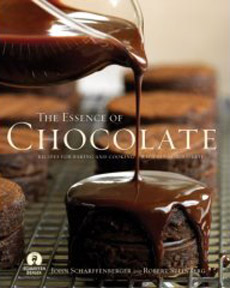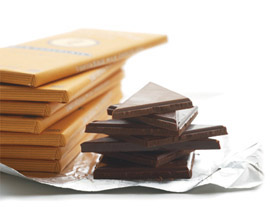

Revel in fine chocolate as you bake, cook and learn about its origins and manufacture.
|
| KAREN HOCHMAN is editorial director of THE NIBBLE™.
|
|
December 2006
|
 |
The Essence Of Chocolate: Recipes For Baking & Cooking With Fine Chocolate
By John Scharffenberger, Robert Steinberg and Susie Hess
In 1996, winemaker John Scharffenberger and physician Robert Steinberg joined forces to focus full-time on making artisanal chocolate. Establishing a factory in South San Francisco and expanding to Berkeley, California, in short order they became one of America’s leading chocolate companies. Handing his product to luminaries such as Julia Child and Jacques Pepin, Scharffenberger got great buzz. Soon enough the product become a preferred brand of baking chocolate among professional patissiers and serious home bakers. California consumers helped establish the brand: they read about it and wanted it, forcing the company to make eating bars. (The company had initially planned to focus on baking products; today, it makes bar chocolates for eating, baking chocolate, cocoa powder, cacao nibs and a few “panned products”—chocolate-covered cacao nibs, Champagne grapes, coffee beans and crystallized ginger. At this point only dark chocolate is produced.)
In less than ten years, the artisan chocolatier was purchased by mega-chocolate company Hershey’s. By then, the Scharffen Berger factory had become a tourist destination in the San Francisco Bay area. The founders’ first cookbook (along with Susie Heller, who tested all the recipes and contributed quite a few), The Essence of Chocolate: Recipes for Baking and Cooking With Fine Chocolate, is interesting on two fronts. The 100+ recipes, mostly sweet but some savory, are luscious. Few are those of the authors: they called on the professional chefs and patissiers who use the couverture—many Bay Area chefs but also national and international names like Rick Bayless, Rose Levy Beranbaum and Pepin. The book includes excellent cooking tips and recommends must-have kitchen tools, presumably from the kitchen pros.
Chocolate connoisseurs who do not bake or cook, and thus might never buy this book for its recipes, will still enjoy the story of Scharffen Berger Chocolate Maker—more about that later—and Deborah Jones’ divine photographs, which are worthy of a pinup calendar.
Everyday Delights
One of the very nice things about this book is that, for all its luxe appearance, it is about dishes to be enjoyed every day. No arcane skills are required to make the recipes (some, like Chocolate Caramels, take more time and patience than skill). Unlike the “aspirational” food in many cookbooks, you don’t need to plan a party to attempt the Chocolate Chunk Challah, Muffins or Scones; Chocolate Biscotti, Chocolate Chocolate Cupcakes, Banana Caramel Cake, Chocolate Pudding Cake, Chocolate Mint Basil Ice Cream, Chocolate-Marbled Gingerbread or Chocolate Chunk Cheesecake. The savory dishes are meant for every day too: Chile-Marinated Flank Steak, Tortilla Soup, Cocoa Rub for poultry, lamb and pork. You’ll see how to incorporate cacao nibs into dishes like squash, salad and goat cheese; how to add chocolate or cocoa to impart more complex flavor to barbecue sauce, baked beans and chili. Even the “fancy recipes” don’t require a special occasion, but can be served any weekend: Chocolate Mousse, Chocolate Ginger Pots de Crème, Cocoa Caramel Panna Cotta.
No-Cook Options
If you don’t have time to bake or cook, the authors show that you can sprinkle cacao nibs on your morning oatmeal. They advise you to buy a pepper grinder for nibs and grind them on absolutely everything, from (presumably) your morning eggs and toast to fruit salad to the last cup of coffee or glass of milk of the day. Jacques Pepin tells of grating chocolate on his morning toast, and how, more specifically, a friend of John Scharffenberger’s enjoys it grated on whole wheatberry toast each morning, along with a latte.
What cooks need to know is that these recipes are all based on Scharffen Berger chocolate. It is not so stated, but rather than the  100% cacao baking chocolate recipes have traditionally used, these recipes have been developed by professionals using the company’s specific couvertures of 55% 62%, 70%, 82% and 99% cacao. While one can safely substitute 100% for the 99%, this can’t be done elsewhere, as the entire flavor of the recipe is based on that particular cacao percentage and the corresponding amount of sugar in the recipe. Plus, a chef selects 62% rather than 82% to achieve a different degree of intensity of chocolate flavor. Thus: salivate over the photos, moon over the recipes—but if you want to make them, you’re going to have to go out and buy the Scharffen Berger couverture (or a similar percentage from another producer), or use the cumbersome conversion page to figure out how to translate the “semisweet” or “bittersweet” chocolate you typically use. But buyers of this book would do well to try the company’s products: Scharffen Berger makes terrific chocolate for cooking and baking. And since their light roast brings out the red fruit characteristics of the cacao, baking with it will bring out different qualities than using Valrhona, Guittard or other couverture. Try the recipes with different couvertures and see if you notice the difference. 100% cacao baking chocolate recipes have traditionally used, these recipes have been developed by professionals using the company’s specific couvertures of 55% 62%, 70%, 82% and 99% cacao. While one can safely substitute 100% for the 99%, this can’t be done elsewhere, as the entire flavor of the recipe is based on that particular cacao percentage and the corresponding amount of sugar in the recipe. Plus, a chef selects 62% rather than 82% to achieve a different degree of intensity of chocolate flavor. Thus: salivate over the photos, moon over the recipes—but if you want to make them, you’re going to have to go out and buy the Scharffen Berger couverture (or a similar percentage from another producer), or use the cumbersome conversion page to figure out how to translate the “semisweet” or “bittersweet” chocolate you typically use. But buyers of this book would do well to try the company’s products: Scharffen Berger makes terrific chocolate for cooking and baking. And since their light roast brings out the red fruit characteristics of the cacao, baking with it will bring out different qualities than using Valrhona, Guittard or other couverture. Try the recipes with different couvertures and see if you notice the difference.
The Past, The Present & The Future
The recipe chapters are interspersed with chapters on cacao and the personal and corporate journeys of Scharffenberger and Steinberg: how each decided to go into the chocolate business and what it took to get there, how Steinberg, the chocolate-maker (Scharffenberger ran the business prior to growing large enough to hire someone to manage the day-to-day), taught himself to make chocolate in his apartment kitchen, how cacao is grown, and how he discovered that, given great bean genetics, proper fermentation was the key to great chocolate. Whether the authors or the editors chose to divide the chapters this way we do not know, but it doesn’t make much sense to us. People looking for recipes are not going to stop to read a chapter about building the factory, and people reading about cacao genetics, the fermentation of beans and the biting midge can’t help but find it strange to have to cross a chapter on chocolate sauce recipes to the next chapter on the authors’ travels to procure the best beans as they help the livelihood of farmers in places like Ecuador and the Dominican Republic. There are two different books here, the recipe book and the cacao book, and an attempt to unite them by intercutting makes the contents even more disjointed. If the book goes into re-print, we’d love to see all of the cacao information logically together in its own “Part II.”
These latter chapters may be of more interest to chocolate geeks than the average home baker, but if it inspires anyone to more chocolate scholarship, the seven books recommended as “Suggested Reading” are a good beginning. Buy all means, start by buying this “The Essence of Chocolate.” It’s a great read, and a great “cook,” too.

|





 100% cacao baking chocolate recipes have traditionally used, these recipes have been developed by professionals using the company’s specific couvertures of 55% 62%, 70%, 82% and 99% cacao. While one can safely substitute 100% for the 99%, this can’t be done elsewhere, as the entire flavor of the recipe is based on that particular cacao percentage and the corresponding amount of sugar in the recipe. Plus, a chef selects 62% rather than 82% to achieve a different degree of intensity of chocolate flavor. Thus: salivate over the photos, moon over the recipes—but if you want to make them, you’re going to have to go out and buy the Scharffen Berger couverture (or a similar percentage from another producer), or use the cumbersome conversion page to figure out how to translate the “semisweet” or “bittersweet” chocolate you typically use. But buyers of this book would do well to try the company’s products: Scharffen Berger makes terrific chocolate for cooking and baking. And since their light roast brings out the red fruit characteristics of the cacao, baking with it will bring out different qualities than using Valrhona, Guittard or other couverture. Try the recipes with different couvertures and see if you notice the difference.
100% cacao baking chocolate recipes have traditionally used, these recipes have been developed by professionals using the company’s specific couvertures of 55% 62%, 70%, 82% and 99% cacao. While one can safely substitute 100% for the 99%, this can’t be done elsewhere, as the entire flavor of the recipe is based on that particular cacao percentage and the corresponding amount of sugar in the recipe. Plus, a chef selects 62% rather than 82% to achieve a different degree of intensity of chocolate flavor. Thus: salivate over the photos, moon over the recipes—but if you want to make them, you’re going to have to go out and buy the Scharffen Berger couverture (or a similar percentage from another producer), or use the cumbersome conversion page to figure out how to translate the “semisweet” or “bittersweet” chocolate you typically use. But buyers of this book would do well to try the company’s products: Scharffen Berger makes terrific chocolate for cooking and baking. And since their light roast brings out the red fruit characteristics of the cacao, baking with it will bring out different qualities than using Valrhona, Guittard or other couverture. Try the recipes with different couvertures and see if you notice the difference.